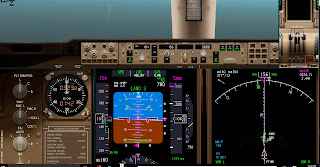DIFFICULT WEATHER CONDITION
With difficult weather conditions testing the muscles of pilots into YMML (Melbourne) and other states across Australia although thankfully they now seem to have passed crosswinds have been blowing, hard ,including Sydney (YSSY) earlier in the week and early yesterday making it difficult to land the little used Runway 25/07 was pressed back into service with a length of 8,300 feet by 145 feet.
2. Crosswinds require constant monitoring (but don`t go chasing the airspeed) .Where have I heard that before?
3. The Aerowinx is a very realistic simulator for training (but we knew that, right).
You can also view some footage of the crash on YouTube which I`ll let you locate
1. 22 knots
2. 30 knots
3. 25 knots
The A380 & "large" aircraft were left to the mercy of downwind components & nasty crosswind limits on longer RW (runway) 16/34.
So to test my crosswind skills I set myself up on Aerowinx to fly the B744 in the same conditions as set out below.
What the screen dump doesn`t show is the major changes in airspeed from second to second, notice the downwind arrow next to the airspeed of 154 knots on the PFD (Primary Flight Display) & the left facing trend vector on the ND (Navigational Display).I managed to succeed on the third approach after letting the aircraft bounce, similar to the embedded video.
What I learnt is
1.The B747 is a forgiving aircraft if you have proper technique.2. Crosswinds require constant monitoring (but don`t go chasing the airspeed) .Where have I heard that before?
3. The Aerowinx is a very realistic simulator for training (but we knew that, right).
You can also view some footage of the crash on YouTube which I`ll let you locate
1. 22 knots
2. 30 knots
3. 25 knots
I read of a B744 accident at KSFO (San Francisco Airport) in the very early days flown by Capt.Dyer involving some crosswind but major systems loss.Had the accident had a greater impact the sales of the Boeing 747 may well have suffered. You can read the report here.www.ntsb.gov/investigati…/AccidentReports/…/AAR7217.pdf.
As far as I can tell Capt.Dyer never flew again commercially but the accident could have been avoided had various US agencies done their job properly. This accident led to the development of Situational Awareness & Cockpit Resource Management & is used frequently in the training room.
There is also a 10 minute training video here https://youtu.be/tl_wXfSwRzM about the circumstances surrounding the accident very comprehensively.
Here is this weeks question:
What is the maximum wind limit for crosswind while doing an auto land?
Answer on Wednesday as Mid Week Encouragement;available on page 241 of the original manual.
May all of your crosswind landings be successful ones. Kind regards from a sunny Sydney till next time,
Neil
PS Apologies for not posting last week due to fatigue from IT demands which have tested my patience in recent times.
PS Capt Dyers grandson may yet do a documentary about what really happened behind the scenes of the accident to enhance his reputation;Wikipedias summary is too basic.

Comments
Post a Comment